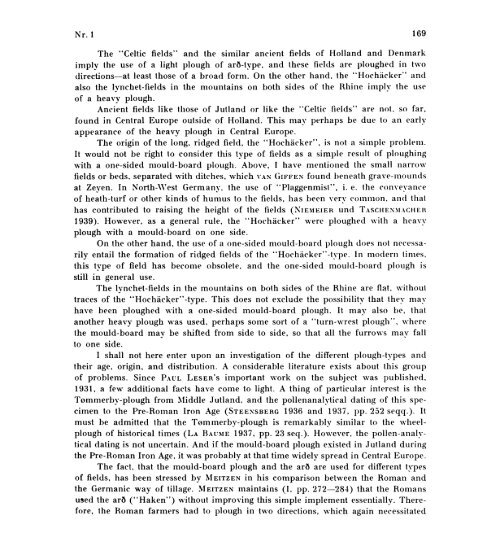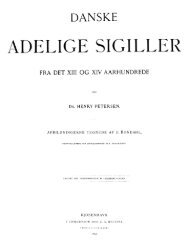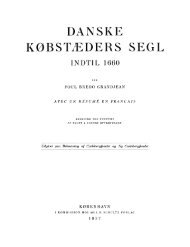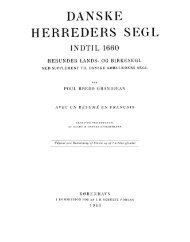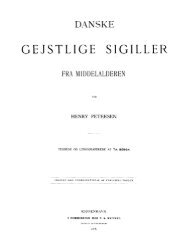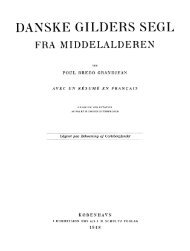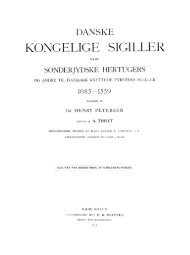Oldtidsagre - Genstandskundskab
Oldtidsagre - Genstandskundskab
Oldtidsagre - Genstandskundskab
You also want an ePaper? Increase the reach of your titles
YUMPU automatically turns print PDFs into web optimized ePapers that Google loves.
Nr.1 169<br />
The “Celtic fields" and the similar ancient fields of Holland and Denmark<br />
imply the use of a light plough of arð-type, and these fields are ploughed in two<br />
directions-at least those of a broad form. On the other hand. the “I~Iochäcker" and<br />
also the lynchet-fields in the mountains on both sides of the Rhine imply the use<br />
of a heavy plough.<br />
Ancient fields like those of Jutland or like the “Celtic fields" are not, so far,<br />
found in Central Europe outside of Holland. This may perhaps be due to an early<br />
appearance of the heavy plough in Central Europe.<br />
The origin of the long, ridged field, the “I-Iochäcker", is not a simple problem.<br />
It would not be right to consider this type of fields as a simple result of ploughing<br />
with a one-sided mould-board plough. Above, I have mentioned the small narrow<br />
fields or beds, separated with ditches, which vAN GIFFEN found beneath grave-mounds<br />
at Zeyen. In North-\Vest Germany, the use of “Plaggenmist", i. e. the conveyance<br />
of heath-turf or other kinds of humus to the fields, has been very common, and that<br />
has contributed to raising the height of the fields (NIEMEIER und TASCHENMACHER<br />
1939). However, as a general rule, the “Hochäcker" were ploughed with a heavy<br />
plough with a mould-board on one side.<br />
On the other hand, the use of a one-sided mould-board plough does not necessarily<br />
entail the formation of ridged fields of the “I-Iochäcker"-type. In modern times.<br />
this type of field has become obsolete, and the one-sided mould-board plough is<br />
still in general use.<br />
The lynchet-fields in the mountains on both sides of the Rhine are flat, without<br />
traces of the “Hochäcker"-type. This does not exclude the possibility that they may<br />
have been ploughed with a one-sided mould-board plough. It may also be, that<br />
another heavy plough was used, perhaps some sort of a “turn-wrest plough", where<br />
the mould-board may be shifted from side to side, so that all the furrows may fall<br />
to one side.<br />
I shall not here enter upon an investigation of the different plough-types and<br />
their age, origin, and distribution. A considerable literature exists about this group<br />
of problems. Since PAUL LEsER's important work on the subject was published,<br />
1931, a few additional facts have come to light. A thing of particular interest is the<br />
Tømmerby-plough from Middle Jutland, and the pollenanalytical dating of this specimen<br />
to the Pre-Roman Iron Age (STEENSBERG 1936 and 1937, pp. 252 seqq.). It<br />
must be admitted that the Tømmerby-plough is remarkably similar to the wheelplough<br />
of historical times (LA BAUME 1937, pp. 23 seq.). However, the pollen-analytical<br />
dating is not uncertain. And if the mould-board plough existed in Jutland during<br />
the Pre-Roman Iron Age, it was probably at that time widely spread in Central Europe.<br />
The fact, that the mould-board plough and the arð are used for different types<br />
of fields, has been stressed by MEITZEN in his comparison between the Roman and<br />
the Germanic way of tillage. ÄIEITZEN maintains (I, pp. 272-284) that the Romans<br />
used the arð (“Haken”) without improving this simple implement essentially. Therefore,<br />
the Roman farmers had to plough in two directions, which again necessitated


